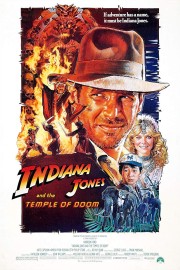Indiana Jones and the Temple of Doom
I have so many questions about that opening musical number with Willie Scott singing “Anything Goes.” Ok, I really just have one, and that is, who is that big chorus line section for? Of course, that’s rhetorical because Steven Spielberg understands that this is a cinematic musical number and not just a live one for the audience in the scene. That element is one of my favorite parts about the scene that opens he and George Lucas’s second Indiana Jones adventure.
I didn’t watch “Temple of Doom” quite as much as a kid as I did “Raiders” and “Last Crusade,” although I’m not sure I was entirely as turned off at its darker tone as others were. I didn’t dislike Kate Capshaw’s obnoxious Willie as others did, and I enjoyed the adventure Spielberg and co. took Indiana on, as well as the imagery and John Williams’s music. When I was younger, I’m not sure if I would have been able to articulate my thoughts about “Temple of Doom.” Now, it’s time to look at the film critically, and how it stakes up to “Raiders of the Lost Ark.” That’s no small task.
The original Indiana Jones trilogy has one masterpiece at the start (“Raiders”), and an enjoyable, but derivative third chapter (“Last Crusade”), with a second film that goes into darker territory than either film before or after it. That structure follows very much with the original “Star Wars” trilogy, but “Empire Strikes Back” still has a joyful escapist energy to it, with a solid thematic structure around it. In “Temple of Doom,” Spielberg, Lucas and writers Willard Huyck and Gloria Katz (who would later do “Howard the Duck”) are not as on strong a motivational footing as we see in “Raiders” and “Last Crusade.” Part of that is that the Nazis are easy villains to dislike in those films, and while the Thuggee death cult at the center of “Temple of Doom” are evil incarnate, and there is also a reliance on Indian stereotypes and ethnic cliches that are uncomfortable to watch come from a filmmaker whose career afterward would be partially defined by his compassion for the downtrodden, and his clear rejection of hate. But as Spielberg and Lucas would tell you, they were in dark places personally when this film was in production (both were in the middle of contentious divorces), and that bled over into the film itself.
The film begins in Shanghai in 1935, with Indiana Jones (Harrison Ford) looking to make a deal with a crime boss for the remains of a Chinese emperor at the night club that Willie Scott is performing at, and when that scene escalates, Indy and Willie end up jumping out a window into a car driven by Short Round (Ke Huy Quan), Indy’s young partner in this film. They get away, and get on a plane heading towards Delhi that ends up crashing. They escape, but they find themselves washed up on the shore near a destitute Indian village where not only has an ancient stone been stolen, but their children have been taken, as well. This leads Indy, Willie and Short Round to Pankot Palace to investigate, with all of them having “fortune and glory” on the brain, but as they discover, something more important than personal glory is at stake.
Willie Scott is annoying, to be sure, but Capshaw makes us aware of that in her performance, and she plays into the fact that she is a hindrance to Indy and Short Round at every turn, except when she just happens to be useful in saving them from being crushed. I’ve always been a Short Round fan, and between this and “The Goonies,” Quan is one of my favorite supporting actors from my childhood, and the moments he shares with Ford in this film- whether it’s them playing cards or fighting bad guys, or when he has to bring Indy out of the dark sleep of Kali- have always been some of my favorite moments in this film. And as the Thuggee cult leader, Mola Ram, Amrish Puri has always been one of the villains whom has stood out as a particularly sinister one, with his face-to-face moments with Ford bringing a strong malevolence to the film that makes it feel more impactful than just a Hollywood adventure. Of course, when you begin to talk about the Thuggee and the portrayal of India in this film is where some of the more problematic parts of the film come into focus. I don’t think anyone was trying to be deliberately offensive as they came up with this story, but it’s not hard to see why it was a hard “no” on India for allowing them to shoot the film there.
The adventure in this movie is ultimately what elevates it to the level of entertainment it achieves, especially when we go into the depths of the Palace, and see the Thuggee ritual. Yes, it’s ugly business, but as Indy, Short Round and Willie try to navigate the situation, Spielberg directs some sensational action set pieces that have been some of my favorites in the trilogy for decades, whether it’s the booby trap in the walls of Willie’s bedroom; the mine car chase; Indy saving the slave children, a moment which has probably the most heroic profile shot (with Williams’s fantastic music goosing its impact) of Indy in any of the films; or the ending on the bridge, Spielberg may have been miserable making this film, and they may have ruffled some feathers, but “Temple of Doom” has him doing some of his most daring and imaginative action in any film he’s directed.










